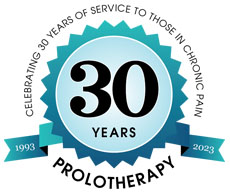Every day people come into our office wracked with chronic joint pain that did not respond to traditional treatments like cortisone injections and because they want to avoid surgery, or even a second or third surgery. Chronic pain continues until the root cause is eliminated. What do we see as the root cause of most joint pain? Joint instability! Most patients are not even aware that they have it and are shocked to find out! Sometimes I will quiz patients about what they think caused their pain. They usually blame an MRI finding, like a bulging disc or bone spur. That is incorrect. As a physician and educator, I want to help patients understand how and why their conditions developed. With the average attention span dwindling, I realize my window to teach patients is small. Not everyone finds joint instability as fascinating as my team does, but that is why patients seek our help…because we’ve done all the homework!
Joint instability occurs due to damaged or weakened ligaments whose job it is to stabilize our joints, including the vertebrae. Ligaments connect bone to bone and should be tight and strong to allow surrounding muscles to move the joint. When ligaments are loose, damaged, or weak, abnormal forces are transmitted through the joint. As the unstable joint is used during daily activities or athletics, abnormal forces progress into destructive joint motion. This progressive disorder eventually begins to kill cartilage cells, allow discs to bulge, pinch nerves, cause bone spurs, and other degenerative changes that are eventually seen on x-ray and MRI.
Joint instability can be diagnosed by ultrasound and physical exam. To alleviate the root cause of joint instability, and the resulting chronic pain conditions, ligaments must be repaired. Regenerative injection treatments, like Prolotherapy, are the treatment of choice for curative ligament repair.



